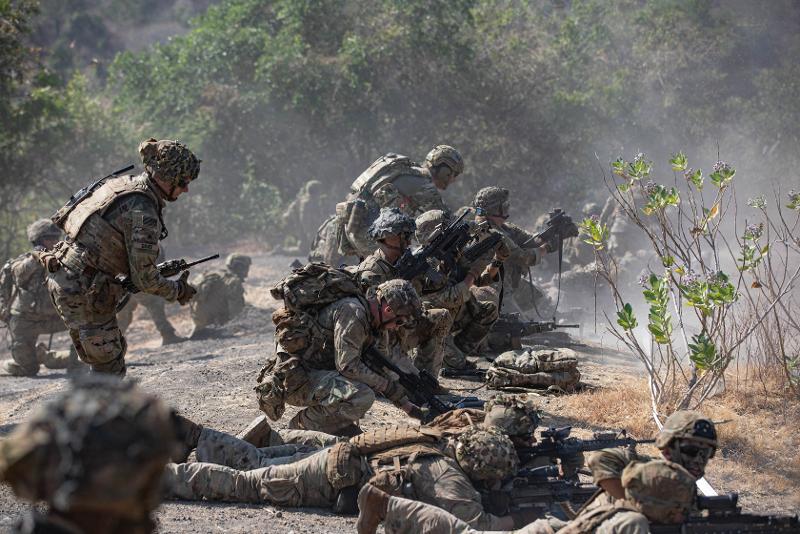In the dynamic landscape of the Indo-Pacific region, the Chinese military stands out with three distinct advantages that give them an edge over their adversaries. These advantages include interior lines, mass, and magazine depth. Join me as we delve into each of these factors and explore their significance in shaping the military dynamics in the region.
Interior Lines: A Strategic Advantage
Explore the concept of interior lines and its significance in the Chinese military's strategy.
The Chinese military's proximity to Taiwan, just 100 miles away, provides them with a strategic advantage known as interior lines. This concept refers to the ability to quickly move forces and resources within a smaller geographical area, enabling rapid response and coordination. With interior lines, the Chinese military can effectively concentrate their forces and respond swiftly to any potential threats.
Furthermore, this proximity allows them to maintain anti-access and area-denial capabilities, including missiles, aircraft, ships, and cyber and space capabilities. These measures serve to keep opposing forces at a distance and limit their ability to operate effectively in the region.
The Power of Mass
Discover how the Chinese military's large military force gives them a significant advantage.
One of the key advantages of the Chinese military is their sheer mass. With a very large military force, they possess the capability to project power and overwhelm their adversaries. This mass allows them to maintain a strong presence in the region and exert influence over neighboring countries.
Having a large military force also provides them with the ability to conduct multiple operations simultaneously, giving them a strategic advantage in potential conflicts. This mass, combined with their other advantages, makes the Chinese military a formidable force in the Indo-Pacific region.
Magazine Depth: Ammunition at Scale
Explore the concept of magazine depth and its implications for the Chinese military's capabilities.
Magazine depth refers to the Chinese military's ability to maintain large quantities of stand-off munitions. This includes a wide range of weapons and ammunition that can be deployed from a distance, allowing them to strike targets effectively without putting their forces at risk.
With magazine depth, the Chinese military can sustain prolonged operations and maintain a continuous offensive capability. This capability poses a significant challenge for opposing forces, as it requires them to counter a vast arsenal of weapons and ammunition.
The Role of Land Power in the Indo-Pacific
Understand the importance of land power and the role it plays in defending national sovereignty in the Indo-Pacific region.
While air and sea power are often emphasized, land power plays a crucial role in defending nations' national sovereignty and protecting their territorial integrity in the Indo-Pacific region. Ground forces make up a significant portion of the militaries in the region, ranging from 65% to 80%.
Land power, including armies, provides a physical presence and deterrence against potential aggression. It allows nations to maintain control over key terrain and deny adversaries the ability to establish a foothold. The armies in the Indo-Pacific region are an absolute central part of the defense strategy, working in conjunction with air and sea power to maintain stability and deter potential conflicts.
Deterrence and Collaboration: Countering Chinese Aggression
Explore the measures taken by the U.S., allies, and partners to deter Chinese aggression in the Indo-Pacific region.
To counter the Chinese military's advantages, the U.S., allies, and partners in the region are implementing various measures. These include increased bilateral and multilateral training exercises to enhance interoperability and readiness.
The U.S. Army's new training center in the region serves as a hub for joint training and collaboration, enabling forces to better understand and counter Chinese tactics. Additionally, nations are investing in defense capabilities and working together to improve their overall deterrence posture.
By strengthening their collective defense capabilities and maintaining a strong physical presence in the region, the U.S. and its allies aim to deter Chinese aggression and maintain stability in the Indo-Pacific.
Conclusion
In conclusion, the Chinese military possesses three key advantages that set them apart in the Indo-Pacific region. These advantages include interior lines, mass, and magazine depth. The strategic positioning of their forces, combined with their large military force and extensive arsenal, gives them a significant edge over their adversaries.
However, the U.S., allies, and partners in the region are actively working to counter Chinese aggression through increased collaboration, training exercises, and defense investments. By maintaining a strong physical presence and enhancing interoperability, they aim to deter potential conflicts and maintain stability in the Indo-Pacific.
FQA
How do interior lines give the Chinese military an advantage?
Interior lines allow the Chinese military to quickly move forces and resources within a smaller geographical area, enabling rapid response and coordination. This strategic advantage enables them to concentrate their forces and respond swiftly to potential threats.
What role does land power play in the Indo-Pacific region?
Land power, including armies, plays a crucial role in defending nations' national sovereignty and protecting their territorial integrity in the Indo-Pacific region. Ground forces make up a significant portion of the militaries in the region and provide a physical presence and deterrence against potential aggression.
How are the U.S. and its allies countering Chinese aggression?
The U.S. and its allies are implementing various measures to counter Chinese aggression, including increased bilateral and multilateral training exercises to enhance interoperability and readiness. They are also investing in defense capabilities and working together to improve their overall deterrence posture.

